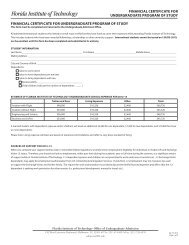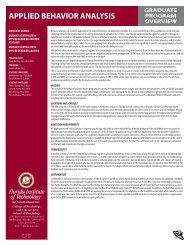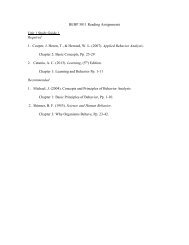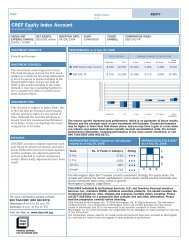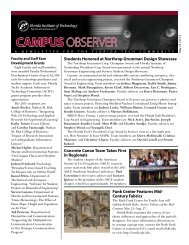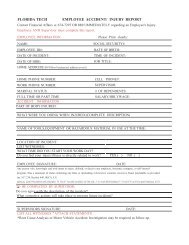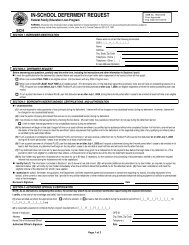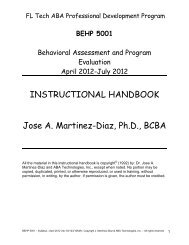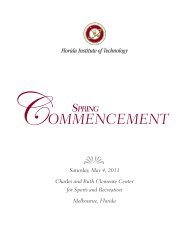2012–2013 UNIVERSITY CATALOG - Florida Institute of Technology
2012–2013 UNIVERSITY CATALOG - Florida Institute of Technology
2012–2013 UNIVERSITY CATALOG - Florida Institute of Technology
You also want an ePaper? Increase the reach of your titles
YUMPU automatically turns print PDFs into web optimized ePapers that Google loves.
Electrical Engineering, Ph.D. ___________________<br />
major Code: 9042 Degree awarded: Doctor <strong>of</strong> Philosophy<br />
age restriction: N admission status: graduate<br />
Delivery mode/s: classroom only Location/s: main campus<br />
admission materials: 3 letters <strong>of</strong><br />
recommendation, résumé, objectives<br />
The doctor <strong>of</strong> philosophy degree is <strong>of</strong>fered to students who want to<br />
pursue advanced research in an area <strong>of</strong> existing faculty expertise.<br />
The doctoral degree is granted in recognition <strong>of</strong> high achievement<br />
in a program <strong>of</strong> study, required examinations and original research<br />
in the field <strong>of</strong> electrical engineering.<br />
Admission Requirements<br />
Admission to doctoral study is granted to applicants who have<br />
received master’s degrees in electrical engineering or related fields<br />
from accredited institutions or from international institutions that<br />
provide suitable preparation for doctoral-level studies.<br />
Included with the application should be a short, clear statement <strong>of</strong><br />
the applicant’s interests and objectives. An on-campus interview is<br />
highly recommended, although not required for admission.<br />
General admission requirements and the process for applying are<br />
presented in the Academic Overview section.<br />
Degree Requirements<br />
The degree <strong>of</strong> doctor <strong>of</strong> philosophy is conferred primarily in recognition<br />
<strong>of</strong> creative accomplishment and ability to investigate<br />
scientific or engineering problems independently, rather than for<br />
completion <strong>of</strong> a definite course <strong>of</strong> study. The work will consist <strong>of</strong><br />
advanced studies and research leading to a significant contribution<br />
to a chosen research area.<br />
The doctoral program in electrical engineering may be completed<br />
with a minimum <strong>of</strong> 48 credit hours beyond the master’s degree.<br />
Each student must complete an approved program <strong>of</strong> study beyond<br />
that required for a master’s degree, pass a comprehensive written<br />
examination, complete a program <strong>of</strong> significant original research,<br />
and prepare and defend a dissertation concerning the research. In<br />
addition, to demonstrate the achievement <strong>of</strong> new knowledge in the<br />
field, a publication in a pr<strong>of</strong>essional journal <strong>of</strong> conference proceedings<br />
is required.<br />
General degree requirements are presented in the Academic<br />
Overview section.<br />
Coursework and Dissertation Summary<br />
Doctoral coursework minimum beyond master’s degree ............................ 24<br />
Doctoral research and dissertation............................................................. 24<br />
TOTAL MINIMUM BEYOND THE MASTER’S DEGREE ................... 48<br />
Curriculum<br />
A minimum <strong>of</strong> 24 credit hours <strong>of</strong> coursework and at least 24 credit<br />
hours <strong>of</strong> Dissertation Research (ECE 6999) beyond a master’s<br />
degree are required. Up to nine credit hours outside <strong>of</strong> electrical<br />
and computer engineering can be counted toward the degree.<br />
The student’s adviser and the department head must approve a<br />
program <strong>of</strong> study. A wide degree <strong>of</strong> latitude is allowed in course<br />
selection and research interest within the capability <strong>of</strong> the university<br />
and the student’s academic background. This requirement is<br />
imposed at the discretion <strong>of</strong> the doctoral committee.<br />
After admission to doctoral candidacy, a yearly seminar demonstrating<br />
progress must be presented to the graduate faculty.<br />
122 <strong>Florida</strong> Tech<br />
RESEARch<br />
Current areas <strong>of</strong> research include image processing,<br />
electromagnetics, computer vision, neural networks, speech<br />
processing, wireless communications and pattern recognition.<br />
These activities are being carried out in relation to the following<br />
general areas <strong>of</strong> research interest.<br />
Electromagnetics: Applied and computational research is conducted<br />
in order to manipulate electromagnetic fields. Antennas,<br />
frequency selective surfaces, high impedance ground planes, and<br />
bandgap structures are designed and analyzed using computational<br />
tools, then tested for validation. The ability to model electromagnetic<br />
properties <strong>of</strong> complex structures requires full-wave analysis<br />
with finite element, method <strong>of</strong> moments or finite difference techniques.<br />
RF measurements are conducted in the antenna laboratory<br />
that houses an anechoic chamber and screen room.<br />
Image processing: Much <strong>of</strong> the research is directed at basic problems<br />
and contributes to the solution <strong>of</strong> major national problems<br />
in vision and image processing. These include automated object<br />
detection and perception, computer imaging, modeling and other<br />
areas <strong>of</strong> image analysis. Techniques being used include traditional<br />
techniques and others that include wavelets, fractals, higher-order<br />
statistics and morphology. Application areas include autonomous<br />
inspection in manufacturing and other commercial uses. Projects<br />
include the fusion <strong>of</strong> infrared and visible imagery, and denoising <strong>of</strong><br />
imagery using advanced methods. In addition, many <strong>of</strong> the techniques<br />
in image processing are being applied to speech processing.<br />
Lightwave and Optronics Laboratories: The laboratories are<br />
dedicated to research and development efforts in the field <strong>of</strong> optical<br />
electronics such as optical communications and optical sensors.<br />
Activities with regards to communication span the development<br />
<strong>of</strong> state-<strong>of</strong>-the-art multi-Tb/s optical transmission architectures<br />
to design and development <strong>of</strong> cryogenic instrumentation for the<br />
space program. Current activities are focused on innovative optical<br />
communications architectures such as spatial and orbital angular<br />
momentum (OAM) photon-based, multiplexing in optical fibers. As<br />
a result, revolutionary capabilities for future optical networks using<br />
hybrid architectures have already started to emerge and several<br />
multi-Tb/s optical systems employing multiple photon degrees <strong>of</strong><br />
freedom were recently reported. Sensor research includes 2-D and<br />
3-D structural health monitoring <strong>of</strong> strain and material failure, and<br />
environmental parameters. These laboratories are equipped with<br />
instrumentation such as tunable lasers, optical spectrum analyzers,<br />
bit error rate test sets, fiber amplifiers and digitally controlled<br />
attenuators, optical time domain reflectometers, fiber splicers and<br />
customized data processing systems for data acquisition and signal<br />
processing.<br />
Microelectronics Laboratory: See the Institution Overview section.<br />
Signal processing: Research is performed in neural networks,<br />
image processing, pattern recognition and speech processing.<br />
Algorithms have been developed for near-real-time detection and<br />
classification for several applications such as communications,<br />
noise reduction, and speaker identification. Techniques being used<br />
include traditional techniques and others that include wavelets,<br />
fractals, higher-order statistics and morphology. Projects include<br />
the analysis and classification <strong>of</strong> infrasound signals, development <strong>of</strong><br />
pattern recognizers, denoising <strong>of</strong> imagery and speech identification.




